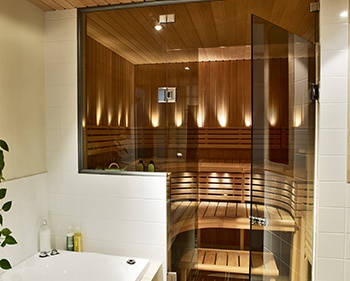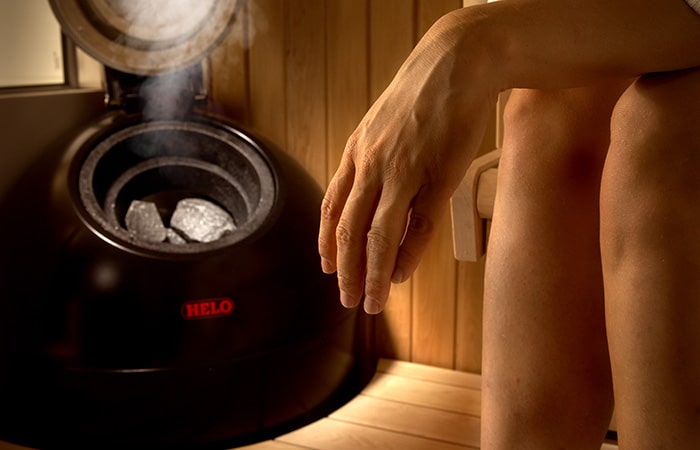Comprehensive guide: how to choose the right materials for sauna ceilings
The sauna is the heart of the Finnish home, a place to relax...
Read moreAn issue that is often (naturally) encountered early on in the sales process when drawing up a plan or a quotation is the price. Therefore, I decided to “open” the costs of a sauna renovation a bit to help budgeting, mainly related to Sun Sauna’s special expertise, i.e. sauna interior (board package, fibre light kit, glass wall, panels and heater).
Often the trickiest area in budgeting is the ceilings. This is because there are so many different types of boards, there are those made by a carpenter from long stock, there are the “self-sawn” prefabricated elements from hardware stores that are cut to the final dimensions on site and, as a third option, there are ready-to-install board packages.
Let’s start with the most cost-effective solution possible. At the higher end of the price spectrum are the “self-sawn” boards available from hardware stores. That is, in a hardware store or online hardware store, the customer can choose the type of timber (width, material, etc.) they want. The boards can then be completely carved by the customer. If you want to make it easier to do the work yourself, you can also buy ready-made modular elements that you can cut to the right size at home. This solution usually costs a few hundred euros plus the hours spent on the work.
Of course, the plus side for the iron trade is the price. It is the cheapest of the board solutions and nowadays the choice of materials is also relatively wide. The disadvantage is the appearance, technical construction and often also the dismantling (for cleaning the sauna) of the lute compared to other alternatives.
The next option is to have the decking made from long timber by a carpenter/joiner. The advantage of this solution, in my opinion, is the “customised” appearance of the boards, i.e. you are unlikely to come across many similar boards. In terms of price, carpenter-made boards are generally at about the same level as prefabricated boards, with some variation in one direction or another. In some cases, the price may be a minus, which, when materials and man-hours are added up, may exceed the price of a ready-made board package. It is also worth asking the carpenter for references of the tiles he has made so that you are not disappointed with the appearance afterwards.
The third option is a prefabricated board package, which includes everything you need (boards, board frames, backrests, spacers and a riser) and installation instructions. This option has the advantage of being ready for installation (tailored to the customer’s dimensions and wishes), with technical solutions and dimensions (frame structure, seat height) and a finished appearance.
Roughly speaking, you should set aside a budget of around €600 to €2000 for the decking. The price will be influenced by the size of the sauna room and the type of tile (straight, L-shaped, U-shaped or facing tile, etc.).
When choosing panels, it is a good idea to consider not only the price per linear metre, but also the properties of the wood and the size distribution of the panels. A low treadmill price can be confusing if the panels have to be bought in 3.5 m lengths and the sauna is small (there will be a lot of wastage).
If you want to treat the panels yourself, for example with Tikkurila Supi-saunavah, you should not choose an expensive panel, in this case a “basic panel” will do. A more expensive quality panel is an option when you want quality and tonality in terms of tone. A quality panel is also characterised by a lack of opacity.

There are also many different lighting solutions available today. The surrounding “sauna ambience” has a big influence on the choice of lighting. A shady cottage sauna on the beach may need nothing more than the flames reflecting through the glass door of a wood-burning stove, while an electrically heated sauna in a detached house sets different standards for lighting from a safety point of view alone.
The most common options today are fibre-optic or LED lighting. LED strip or spots are cheaper than fibre lighting, but at the same time their light output in the sauna degrades more quickly than fibre lighting. LED lights embedded in the backrests can also be difficult to replace when the light fails. Fibres are more expensive than LED lights, but in my opinion also more convenient. Modern technology allows the projector and transformer to be installed inside the sauna room and fibres maintain a good light output. However, both solutions are “mood lighting”, and often a sauna may still have a traditional incandescent light bulb as a cleaning light in addition to the LED or fibre light!
The price for lighting can range from a few tens to a thousand euros (e.g. a large set of fibre lights on the ceiling, plus an illuminated water bowl embedded in the foot bath + a light bank around the stove as a crowning touch).
A glass wall solution on the partition between the sauna and the washroom is a popular solution to give the sauna area an impressive and spacious feel. In addition to a frameless glass door, a glass wall usually includes an upper pane above the door and 1 or 2 side panes of half-wall or full-wall height, depending on whether the door is positioned at the edge or in the middle of the door wall. The cost of the glass wall itself is around €650 to €1000, depending on the glass shade and the sizing of the glass. Technical features such as the type of fixing strips, the type of seals and the hinges and puller also affect the price.
When considering a stove for an electrically heated sauna, the model, size of the sauna and usage habits of the sauna set the requirements for the stove. If you want to integrate the heater into the skirting board, pillar-type heaters are the most practical solution for aesthetic and practical reasons, while if the sauna is small in cubic volume and you do not dream of integrating a heater, a wall-mounted “basic” heater may often be the most suitable option!
Depending on the manufacturer and model, a basic wall-mounted heater costs a few hundred euros, while the price of a pillar-mounted heater is generally upwards of €500. In addition to the models mentioned above, there are also continuously heated “always-on” stoves and soapstone stoves on the market.
